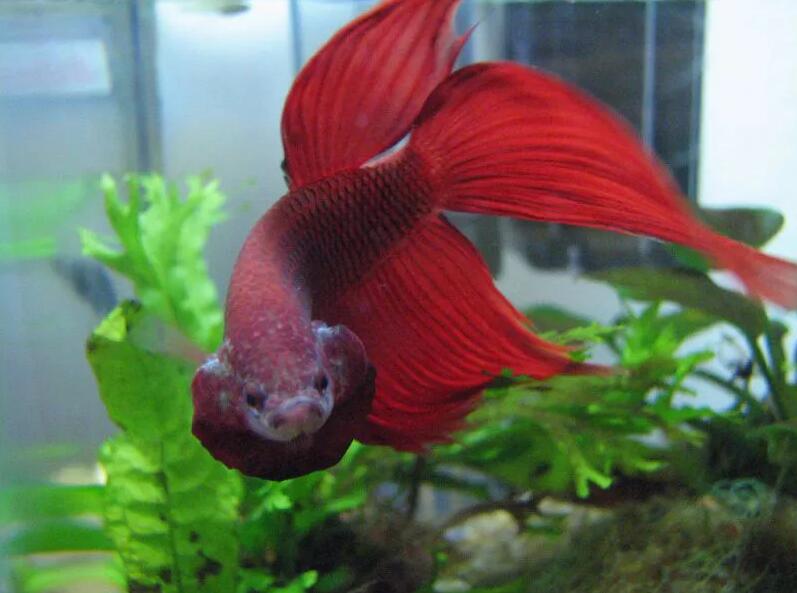The fighting fish, also known as the Siamese fighting fish, is named for its male-on-male aggressiveness. Although individual behavior may vary, most male fighting fish in the pet fish trade need to be kept in a separate aquarium and not even be able to see other males. Fighting in fighting fish can be fatal, so keepers need to take effective measures to prevent males from fighting.
What is the battle of the doujinshi?
The most common fighting behavior in fighting fish is the “flare”. In this demonstration, a male fighting fish pushes both gill covers (gill flaps) forward to indicate a larger body. This is similar to the way a puffer fish expands and protrudes its spines when under duress.
Other behaviors include physical interactions between two fish. Physical interactions may include one fish hitting the other, or swimming directly toward the other fish, or biting or nibbling on the fins. Two male orangutans may also twist together with their lips tightly closed.
Why did the doujinshi fight?
Fighting fish fight to establish territories, including food resources, shelter, and proximity to females. This is a common reason why aggressive behavior occurs in many different fish.
It is a matter of debate whether this fighting behavior in fighting fish is innate or a result of the way they are bred. Studies have shown that pitbulls bred in a group have less tendency to be aggressive Some suppliers have a hard time knowing how your pitbulls are bred and how aggressive they are, and it may take you a few weeks to find out how aggressive they are. However, most male fighting fish are aggressive and should not be kept with other fighting fish.
Fighting fish have a history of being kept as competitive boxers in Thailand, where they originated from. Observations of fighting fish competition have shown that fish kept alone without other fighting fish tend to be more aggressive and fight longer just like dog fighting, and that keeping fish for this particular function is also a serious welfare issue.
Female fighting fish do not usually attack each other. Females are usually kept in a small group, called a “harem”, and individual fish may be more or less aggressive than others in the group, usually resulting in an established hierarchy. Once established, the addition of new females to the harem may lead to increased fighting as the new hierarchy is established. Female fighting fish are usually kept in aquariums with other fish of similar size.
Although male fighting fish cannot be kept with other fighting fish, a male fighting fish can be kept in the same aquarium with other non-aggressive fish. Female fighting fish can also be kept with other fish. Some fighting fish may be aggressive towards other species of fish in the same aquarium if those fish have similar flowing fins as other fighting fish. It is very important to add non-aggressive fish and good community players to your aquarium. It will depend on the personality of your fighting fish to determine if they can be kept with other species. Some fighting fish are too aggressive to be kept with other fish. To reduce any potentially aggressive interactions, fighting fish are best put in the tank last.
Signs of fighting fish
The most common signs of fighting are gill openings, collisions or fin bites. If you don’t see your fish actively fighting, you may see other signs, including missing scales, torn fins, or increased hiding. Severe symptoms include lethargy, loss of appetite, prolonged hiding periods and sudden death. If you see signs of fighting fish, they must be separated.
“Fin rot” or worn fins are a common problem in fighting fish because of their long, flowing fins. Often, this is a common sign of disease and a poorly functioning immune system. Another common cause of fin damage is over-decorating the fins.

How to stop arguing
The best way to stop your fish from fighting is to have only one male fish per tank. If you put your fighting fish in separate tanks, put a visual barrier between the two tanks so that the fighting fish cannot see each other at any given time. A simple aquarium backdrop or a piece of cardboard are effective visual barriers.
Visual toys with mirrors, or mirrors placed near the tank should also be removed. Fighting fish overreact to their own reflections. Although these may be considered “concentrated” items, these are known stressors in fighting fish and should not be added to the fighting fish container. Fighting fish can be injured when they attack toys or their reflections in mirrors.
Some people try to treat with marijuana and Prozac
to reduce the aggressive behavior of the fighting fish. With both treatments, the fighting fish’s aggressive behavior was reduced, but became tolerant to the marijuana dose. Always consult your veterinarian before starting any treatment on your pet fish.

